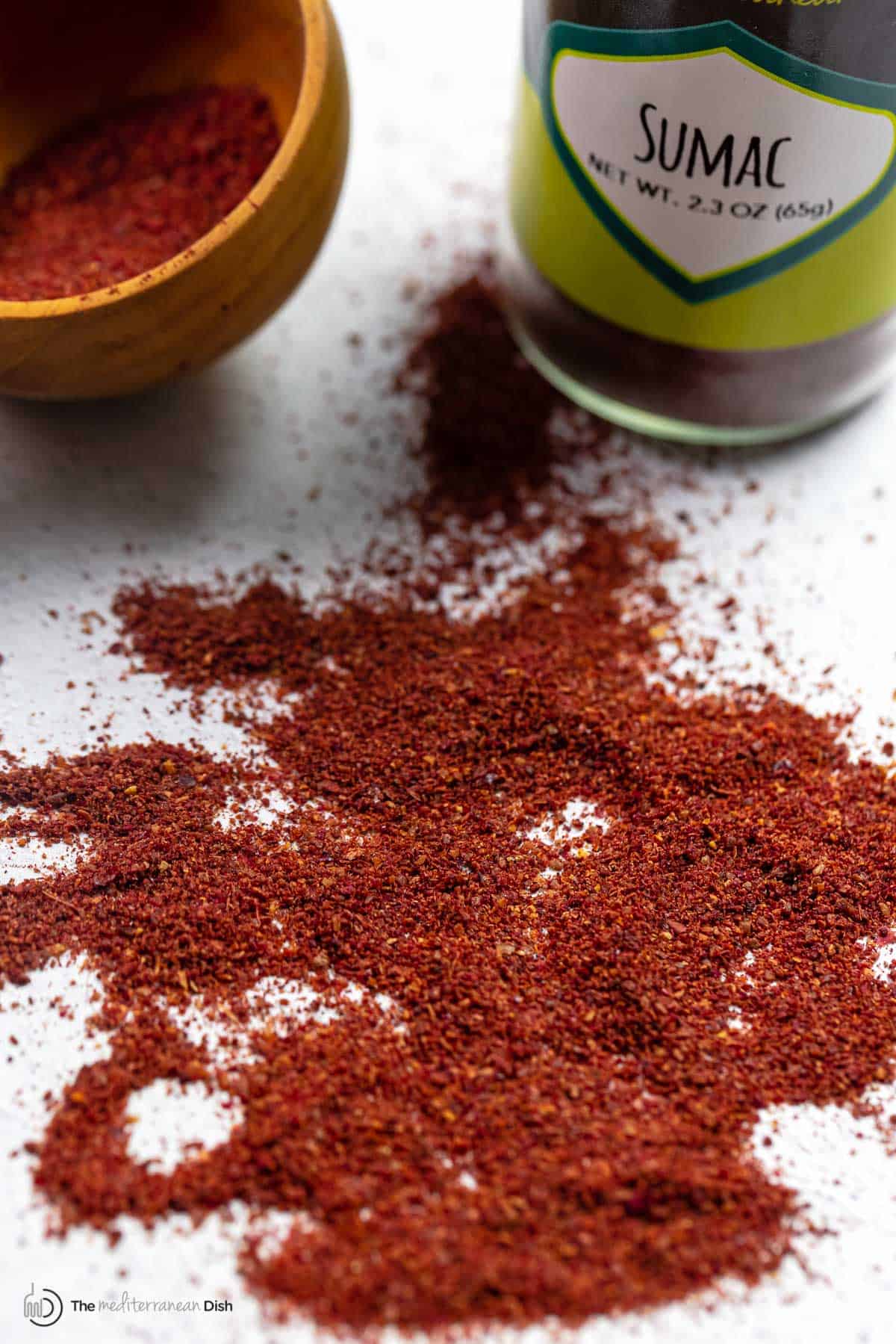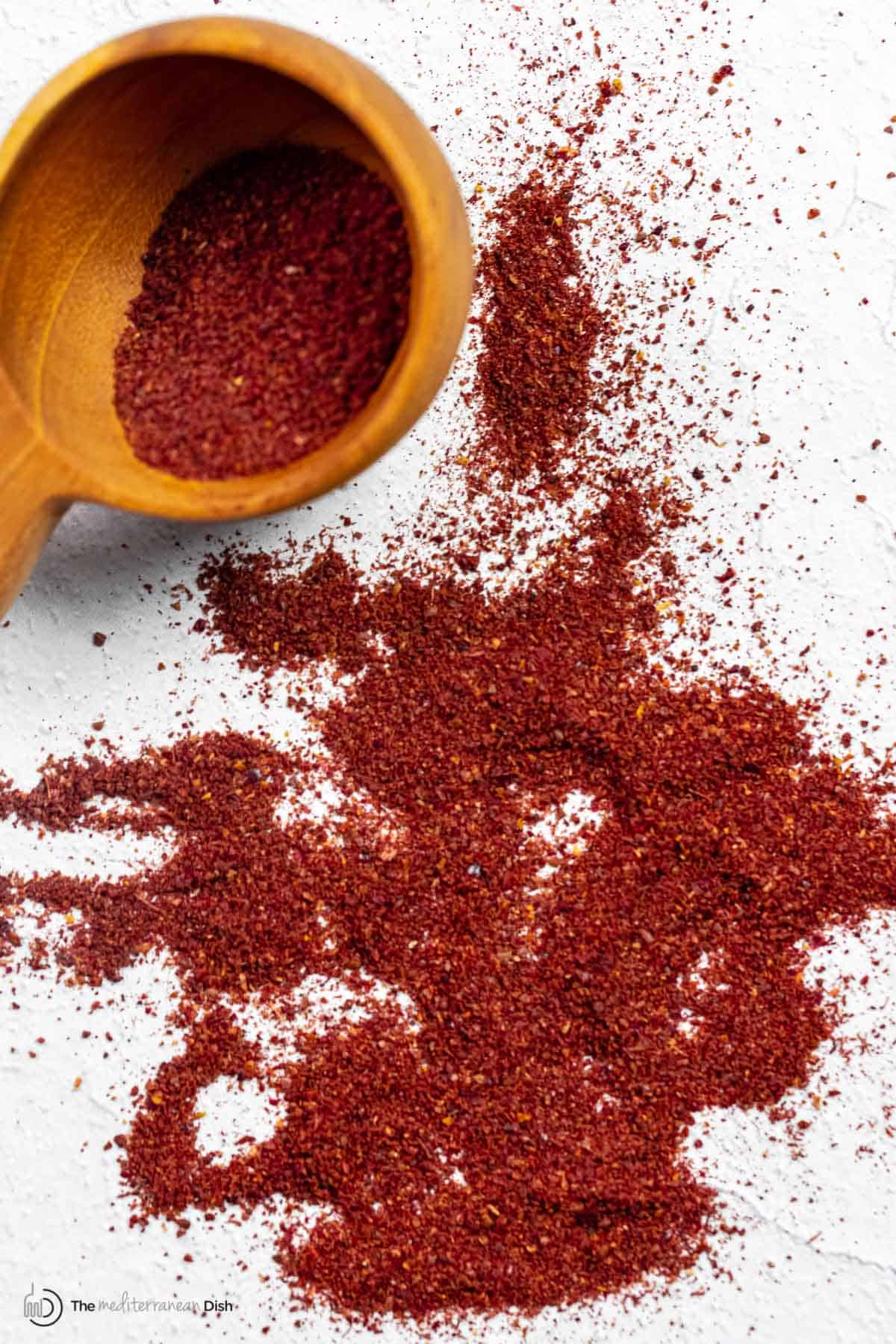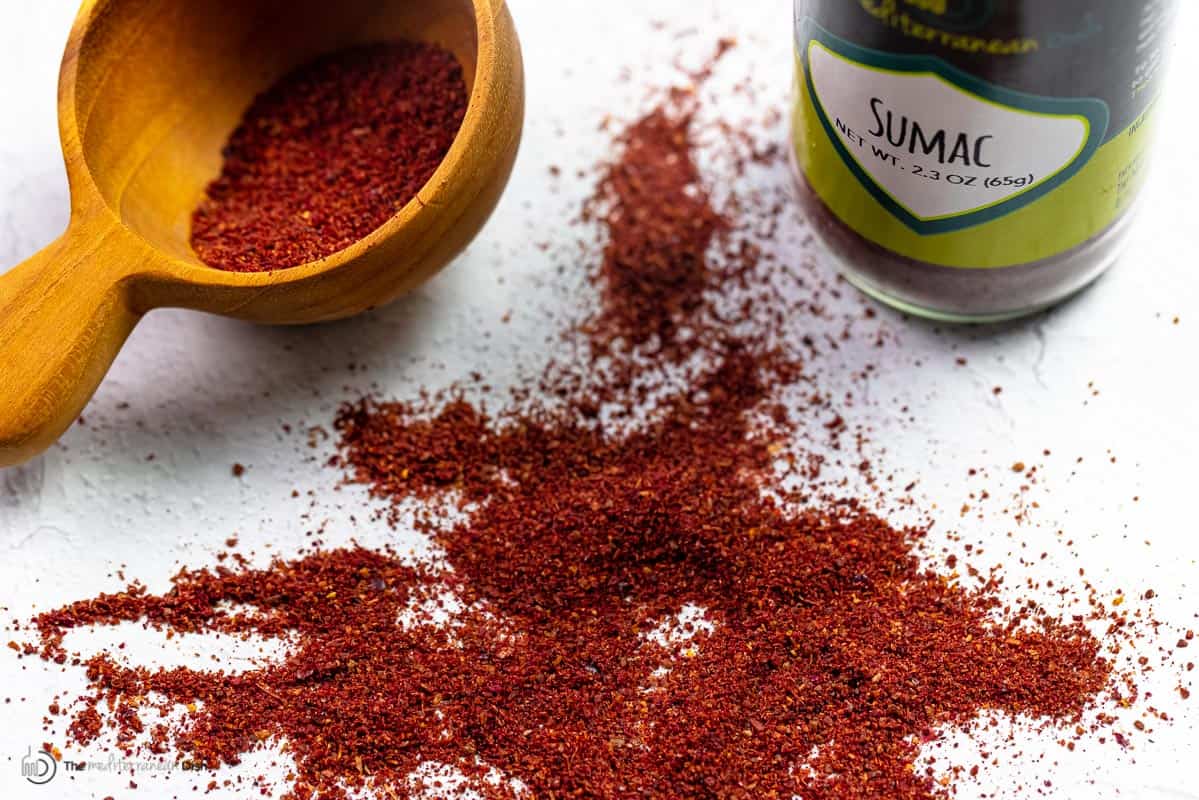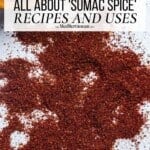Tangy, smoky, earthy, and slightly sour, sumac is an essential spice in Middle Eastern cooking. With its deep red hue and fruity, citrusy flavor, sumac spice is the perfect way to add acidity and color to your meals!

In this post, we’ll learn all about an essential ingredient in the Middle Eastern pantry: sumac. No, we're not talking about the poisonous variety, which is white in color (we’ll make sure you know about that one too so you can avoid it). Sumac spice that is used in cooking is red, more like a deeper berry color. It comes from sumac berries, which are turned into a coarse powder, sifted, and sold in spice bottles for culinary use.
This deep red spice is the main flavor maker in some traditional Middle Eastern dishes like fattoush salad and musakhan, but it is a versatile spice that can add depth and tang to many things including chicken, fish, and all sorts of salads! It is also a main ingredient in zata'ar, and is great combined with other seasonings like allspice and chili pepper flakes to make rubs for grilled meats. I’ll give you a few of my favorite recipes that use this beautiful spice below.
Let’s dive into some burning questions including, exactly what is sumac? How does it taste? And more.
In this post

Sumac
Sumac comes from the Arabic “summaq,” which means “dark red.” It is a crimson red, astringent spice popular in Middle Eastern cooking. It’s made from the berry fruit of the Rhus Coriaria shrub, which were originally grown in parts of the Mediterranean basin, then spread to Europe. The berries are dried, then ground and sifted to get rid of the bitter inner seed. The coarse crimson-colored powder is then bottled as a spice to use in cooking.
This type of sumac is also known as Sicilian sumac or Tanner’s sumac. And it might surprise you to learn that sumac is actually a member of the cashew family, anacardiaceae!
What does sumac taste like?
It tastes somewhat like fresh lemon juice – a bit sour and astringent! But it’s much more complex and nuanced in flavor. Sumac is tangy and deep with a hint of earthy sweetness and floral citrus notes. You just have to try a pinch to know!
Some describe it as a “dry acid”, but it also works a bit like salt in that it brings out the natural flavors of a given food. That’s why it is ideal for dry rubs, and I highly recommend it on chicken or fish like my roasted red snapper!

Cooking with sumac spice
Arabs use it to add tang and tartness, and in general, it is a great way to add lemony flavor to dishes or rubs. And because of its acidity, it pairs wonderfully with meat like lamb, helping to cut through the richness and balance it out. It's also a classic seasoning for astringent red onions, from the onions served with Turkish kebabs to the filling for Middle Eastern Fatayer (Spinach And Onion Savory Hand Pies).
But why stop there? I use the spice in a ton of different ways! Salad dressings, marinades, and even homemade dips are immediately elevated by a sprinkle of this complex spice.
One of my favorite salad dressings requires nothing more than a dash of sumac, extra virgin olive oil, and fresh lemon juice. And as far as marinades and rubs, my grilled chicken drumsticks, whole roasted snapper, and grilled cod would not have the simultaneously bright and earthy flavor they do without the vibrant spice!
And while I love it in marinades and salad dressings, this spice works perfectly as the finishing touch on a variety of dishes (similar to how a squeeze of lemon juice at the end of cooking immediately brightens a dish). Just try sprinkling a dash onto some homemade hummus and you’ll see what I mean. You’ll instantly have a contrast of flavor between the nutty hummus and the sour spice, adding depth with no effort at all.
One really surprising way to use it is in desserts! Yes, you can add a pinch over your ice-cream or fruit, like the macerated strawberries in our strawberry shortcake recipe. Or even in your cookie or brownie batter (I'll be trying that next time I make tahini brownies).
Where to buy it
My favorite all-natural sumac spice is available in our online shop. It is all-natural, and because we intentionally always carry a smaller supply, our spices are more fresh and pungent than what you'll find in your average grocery store.
Middle Eastern stores might sell both the ground kind and whole dried berries. Keep in mind that some sumac spice sold in stores can be mixed with citric acid and food coloring.

Available via our Online Shop
Substitutes
Sumac is quite unique and hard to replace with one ingredient. But you can substitute it by mixing lemon juice and lemon zest with a little kosher salt, vinegar, or tamarind. I find that none of those options provide the same depth of flavor though, but they’ll do in a pinch. If you decide to use one of them, use sparingly, as they are all more sour.
Poison sumac that you should avoid
The easiest way to tell poison sumac is by its color. It has white berries, while the edible kind, as you now know, has deep red berries.
The poisonous variety grows in damp, swampy areas of the eastern United States. Like poison ivy and poison oak, poison sumac contains the toxin urushiol – and the entire plant is poisonous (including the stems and leaves). If you happen to brush against it, you will likely be left with an itchy red rash.
How to store it
When stored correctly, the ground spice can keep for several months. Whole dried berries will keep for over a year! Be sure to store sumac (ground or whole) in an airtight container, away from light and heat – an unheated pantry would do nicely.
Visit Our Online Shop to find this spice and more quality Mediterranean ingredients!



Looking forward to seeing some new recipes
Hi, Victoria! We'll be sure to keep 'em coming! If you want to stay on top of what's new on the site, but sure to click here and sign up for our weekly emails, if you haven't already.
Can sumac be used in place of lemon juice or zest? I sometimes have issues with very acidic foods and need to be careful. Thanks!
The article specifically talks about this.....
Hello l live in Belize south of Mexico this is the first l've about sumac l would like to see it in the online store so l can purchase some in the future. I enjoy Mediterranean food. I used to live in Los Angeles California l used to go to a place in Manhattan Beach for brunch.
When I visit Atlanta next year I want to buy your products of spice and herbs to bring back to New Zealand.
Is there an actual shop or is everything on line. If on line I can pay on line and get it delivered to Berekley Lake area. It's just a long way off till next USA summer.
Katie
Hi, Katie. We don't have a physical shop... only online, but we do ship all over the US, so definitely keep us in mind when you visit!
Just received my order of sumac and 6 other spices! Oh my, they are so aromatic and fresh. I am scouring your website for yummy recipes!
Thanks so much for supporting our shop! Hope you find a lot of good recipes to put all those spices to good use. If you ever need specific suggestions for any of them, please reach out to us at info@themediterraneandish.com. We'd be happy to help!
Buying the ground Sumac....right now but how and what all types of meat and other to use it on?
Hi, Gwendolyn. Sumac is the best, and can be sprinkled on just about anything: soups, salads, eggs, your favorite meats and more! There are several recipes linked in this article if you need even more inspiration. Hope you love it!
Wonderful. I have sumac and didn’t know how to use it to enhance foods. Hoping you’ll have more articles on your other spices. Thanks
Hi, Susanne. That is the plan, so be sure to stay tuned!
Love watching you cook. I have a sensitive stomach. Are all your spices spicy? I’d love to try some.
Hi, Suzanne. There are just a few spices in our shop with a bit of a kick (Aleppo Pepper, Baharat Spice Blend and Ras el Hanout). Two of my favorite non-spicy flavor makers we carry are Za'atar and Sumac. I highly recommend checking those out.
Wanted to let you know how much I am enjoying the Mediterranean diet. It is always satisfying but never leaves me with that “stuffed” feeling.
Thanks, Martha! That is one of the things we LOVE about the Mediterranean way of eating, as well!
Great company
Awww! Thanks, Marcia!
I am from Iran and we always use Sumac exclusively on rice pilaf .now I will try it on my chicken and lamb dishes, thank you
Could/should this spice be used with someone with a nut allergy? I was planning on using it to season our chicken for a picnic this weekend. But now I see your post and you said it’s in the cashew family, now I’m scared to use it because my daughter Inlaw is Allergic to nuts.
Hi, Gloria. It is our understanding that, although Sumac is in the cashew family, it isn't exactly the same as a cashew. That being said, we are not qualified to advise you on whether it would cause an allergic reaction in someone with a nut allergy. If you have any doubts at all, we don't recommend that you use it.
Thank you - great information.
I love sumac! We have salmon once a week, usually grilled on a plank. My go-to seasoning for the fish is sumac. It's also great on grilled or roasted vegetables, zucchini being my favorite.
Thanks for sharing, Jerri!
Hi Suzy, I sautéed organic baby spinach in olive oil and minced garlic. Then I added Parmazon cheese and stirred until combined. Then, at the last minute, I decided to add some sumac. And..... it was SO tasty. I sure enjoy learning new things in the kitchen, even at the age of 87. 🌺
That sounds wonderful, Marlene! Thanks for sharing!
Great info, thank you!
Hi everyone, Just a quick warning, whilst pruning a beautiful stagshorn sumac, the so called non toxic variety, I had a severe allergic reaction to the young stems of the plant. The ambulance was called and I was given antihistamines.
My symptoms were burning itching skin, diahorrea vomiting and I blacked out. This is a very rare reaction but have found out that there have been other cases where this reaction has occurred. So be very careful if using any part of this plant.
Avril
Great info here! I love your sumac... put it on so many things!!
Awesome! Thanks, Meredith!